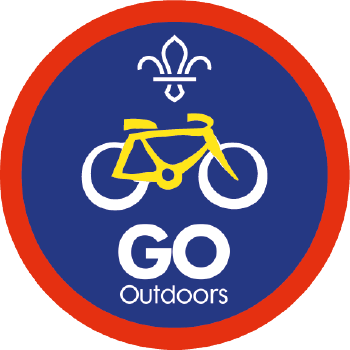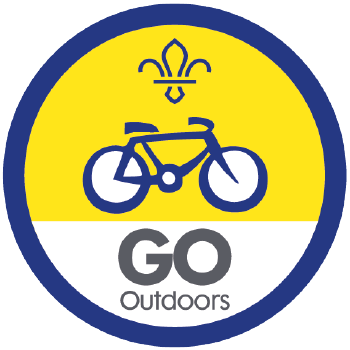
Bike balance gymnastics
You’ll need
- Something to mark lines (for example, chalk, masking tape, or rope)
- Bikes
- PPE, including helmets and pads
- Cones
Before you begin
- Use the safety checklist to help you plan and risk assess your activity. Additional help to carry out your risk assessment, including examples can be found here. Don’t forget to make sure all young people and adults involved in the activity know how to take part safely.
- Make sure you’ll have enough adult helpers. You may need some parents and carers to help out if you’re short on helpers.
- Remember to check the bikes and any safety equipment, such as helmets, before starting.
- Don’t forget to warm up before any physical activity.
Play the games
- Create two parallel lines across your riding surface, about 10cm to 15cm apart, using chalk, cones or masking tape.
- The riders must make their way down, between the two lines, which is the ‘balance beam’. The need to steer between the lines, without going over or touching either line.
- Each player starts with 10 points. You lose a point each time you touch the line.
- To make it harder, you could also lose a point if your foot touches the floor, too.
- To make it easier, you could make the lines wider or let everyone start with 20 points.
- This is a harder version of ‘Balance beam’.
- Create a set of parallel zig zag lines across your riding surface using chalk, masking tape or rope. Try not to make the angles too sharp to start with, as riders may struggle to go round the corners.
- Explain that the riders must make their way down the ‘zig zag’, between the two lines. The need to steer between the lines, without going over or touching either line.
- Each player starts with 10 points and loses points each time they touch a line.
- To make it harder, you could also lose a point if your foot touches the floor or make the zig zags angles harder.
- To make it easier, you could make the lines wider or let everyone start with 20 points.
- Place 2 cones a few metres apart.
- Explain that everyone must try to ride around the cones in a figure of eight pattern. One person could demonstrate the route, or you could draw arrows using masking tape or chalk.
- Once everyone has had a go at riding the figure of eight, move the cones closer together.
- Give everyone 5 points, when someone can’t complete the figure of eighter or puts a foot down, they lose a point.
- Continue until everyone's had a go at riding the different sized courses.
- To extend this activity you could try asking everyone to ride around a larger figure of eight at the same time. Make sure that everyone gives way to each other in the middle!
- Mark a start and finish line using chalk, masking tape or rope. Make sure it’s a few metres apart.
- Explain to the riders that this is a slow race, so it’s all about balance.
- Everyone needs to move forward as slowly as possible in a straight or zig zag line. The winner’s the last person to cross the finish line.
- However, they can’t cycle in circles or wait for everyone else to go. They’ll lose points.
- Any rider who puts a foot down on the ground during the race loses a point, too.
- You could make it a shorter or longer distance to make this game harder or easier. You could also think about starting some racers closer or further away from the finish line to level the playing field.
Reflection
This activity gave everyone the opportunity to develop their skills and be active. What new skills did you learn? Were there any that were easier to complete than others? These activities help us learn to control our bikes at slow speeds as well as work on precision and coordination on our bikes. Why is it important to be able to control our bike at slow speeds? Why is balance important?
Safety
All activities must be safely managed. You must complete a thorough risk assessment and take appropriate steps to reduce risk. Use the safety checklist to help you plan and risk assess your activity. Always get approval for the activity, and have suitable supervision and an InTouch process.
- Outdoor activities
You must have permission to use the location. Always check the weather forecast, and inform parents and carers of any change in venue.
- Adventure
This activity has specific rules and systems to make sure it’s managed safely. Take a look at adventure activities for more guidance.
- Cycle and wheeled activities
Use appropriate protective equipment. You must wear helmets. Wear elbow and knee pads as defined by your risk assessment.
- Active games
The game area should be free of hazards. Explain the rules of the game clearly and have a clear way to communicate that the game must stop when needed. Take a look at our guidance on running active games safely.
- Visits away from your meeting place
Complete a thorough risk assessment and include hazards, such as roads, woodland, plants, animals, and bodies of water (for example, rivers, ponds, lakes, and seas). You’ll probably need more adult helpers than usual. Your risk assessment should include how many adults you need. The young people to adult ratios are a minimum requirement. When you do your risk assessment, you might decide that you need more adults than the ratio specifies. Think about extra equipment that you may need to take with you, such as high visibility clothing, a first aid kit, water, and waterproofs. Throughout the activity, watch out for changes in the weather and do regular headcounts.
For all events, you can explain that speed and style will be considered during judging.
These events can be completed using three wheeled bikes, but the courses would need to be amended accordingly.
You could use bikes with stabilisers to help people build their confidence when riding the bikes.
All Scout activities should be inclusive and accessible.
All the activities can be used as balance warm-ups for any cycling session. You could use it as a warm-up for Les tour de Scouts.
Each event has a winner, but the points everyone earns in each game can be added up to provide an all-around bike balance champion!
Ask young people to create the courses themselves, based on their opinion of their own abilities.
Rather than a zig zag, young people could set chalk courses for each other to follow.

